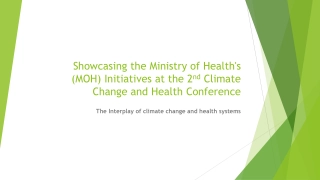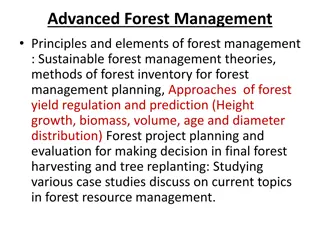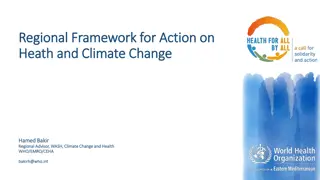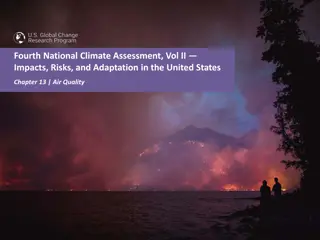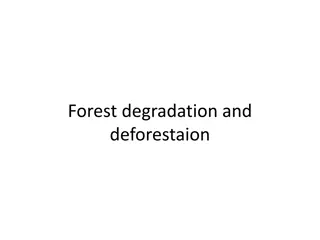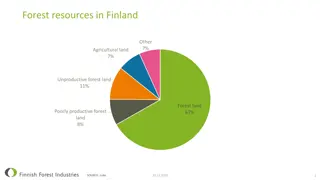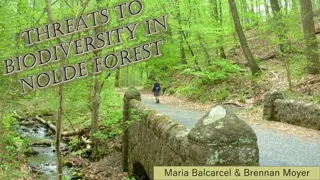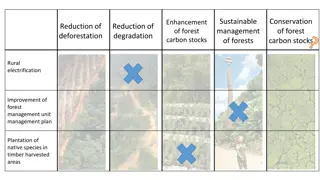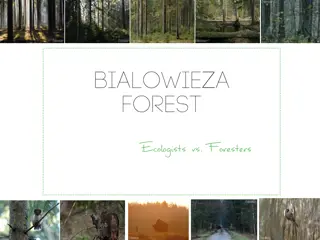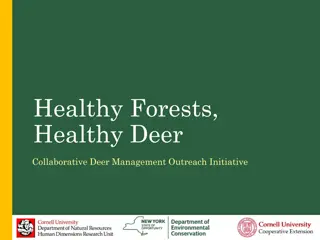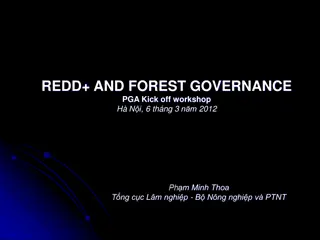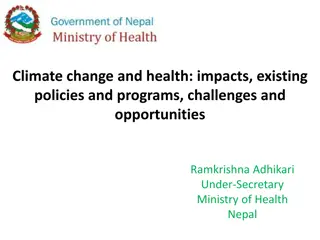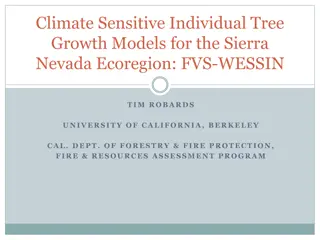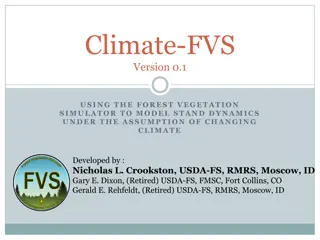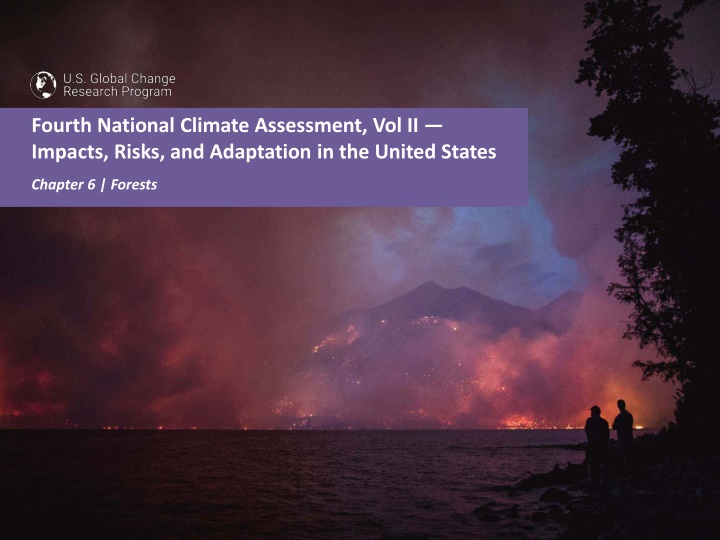
Climate Change Impacts on Forest Health and Ecosystem Services
Frequent extreme weather events are likely to drive ecological disturbances affecting forest structure and function. Climate change is expected to decrease forest ecosystem services, impacting tree growth, carbon storage, and water resources. Adaptation strategies are being implemented to enhance forest resilience to climate change.
Download Presentation

Please find below an Image/Link to download the presentation.
The content on the website is provided AS IS for your information and personal use only. It may not be sold, licensed, or shared on other websites without obtaining consent from the author. If you encounter any issues during the download, it is possible that the publisher has removed the file from their server.
You are allowed to download the files provided on this website for personal or commercial use, subject to the condition that they are used lawfully. All files are the property of their respective owners.
The content on the website is provided AS IS for your information and personal use only. It may not be sold, licensed, or shared on other websites without obtaining consent from the author.
E N D
Presentation Transcript
Fourth National Climate Assessment, Vol II Impacts, Risks, and Adaptation in the United States Chapter 6 | Forests Fourth National Climate Assessment, Vol II Impacts, Risks, and Adaptation in the United States nca2018.globalchange.gov 1
Ch. 6 | Forests Key Message #1 6 Ecological Disturbances and Forest Health It is very likely that more frequent extreme weather events will increase the frequency and magnitude of severe ecological disturbances, driving rapid (months to years) and often persistent changes in forest structure and function across large landscapes. It is also likely that other changes, resulting from gradual climate change and less severe disturbances, will alter forest productivity and health and the distribution and abundance of species at longer timescales (decades to centuries). Fourth National Climate Assessment, Vol II Impacts, Risks, and Adaptation in the United States nca2018.globalchange.gov 2
Ch. 6 | Forests Key Message #2 6 Ecosystem Services It is very likely that climate change will decrease the ability of many forest ecosystems to provide important ecosystem services to society. Tree growth and carbon storage are expected to decrease in most locations as a result of higher temperatures, more frequent drought, and increased disturbances. The onset and magnitude of climate change effects on water resources in forest ecosystems will vary but are already occurring in some regions. Fourth National Climate Assessment, Vol II Impacts, Risks, and Adaptation in the United States nca2018.globalchange.gov 3
Ch. 6 | Forests Key Message #3 6 Adaptation Forest management activities that increase the resilience of U.S. forests to climate change are being implemented, with a broad range of adaptation options for different resources, including applications in planning. The future pace of adaptation will depend on how effectively social, organizational, and economic conditions support implementation. Fourth National Climate Assessment, Vol II Impacts, Risks, and Adaptation in the United States nca2018.globalchange.gov 4
Ch. 6 | Forests Fig. 6.1: Climate Change Effects on Ecosystem Services Many factors in the biophysical environment interact with climate change to influence forest productivity, structure, and function, ultimately affecting the ecosystem services that forests provide to people in the United States and globally. Source: U.S. Forest Service. Fourth National Climate Assessment, Vol II Impacts, Risks, and Adaptation in the United States nca2018.globalchange.gov 5
Ch. 6 | Forests Fig. 6.2: Tree Mortality at Bass Lake Recreation Area A five-year drought in California (2011 2016) led to western pine beetle outbreaks, which contributed to the mortality of 129 million trees. As a result, the structure and function of these forests are changing rapidly. Prolonged droughts are expected to become more common as the climate continues to warm, increasing stress on lower- elevation tree species. Photo credit: Marc Meyer, U.S. Forest Service. Fourth National Climate Assessment, Vol II Impacts, Risks, and Adaptation in the United States nca2018.globalchange.gov 6
Ch. 6 | Forests Fig. 6.3: Fire Damage in Gatlinburg, Tennessee In autumn 2016, a prolonged dry period and arson in the southern Appalachian region resulted in 50 major wildfires that burned over 100,000 acres in 8 states, caused 15 deaths, and damaged or destroyed nearly 2,500 structures in Gatlinburg, Tennessee. If drought or prolonged dry periods increase in this region as expected, fire risk will increase in both forests and local communities. Photo credit: Flickr user highlander411 (CC BY 2.0). Fourth National Climate Assessment, Vol II Impacts, Risks, and Adaptation in the United States nca2018.globalchange.gov 7
Ch. 6 | Forests Fig. 6.4: Wildfires Changes in Area Burned and Cost This figure shows the annual wildfire area burned in the United States (red) and the annual federal wildfire suppression expenditures (black), scaled to constant 2016 U.S. dollars (Consumer Price Index deflated). Trends for both area burned and wildfire suppression costs indicate about a fourfold increase over a 30-year period. Source: U.S. Forest Service Fourth National Climate Assessment, Vol II Impacts, Risks, and Adaptation in the United States nca2018.globalchange.gov 8
Ch. 6 | Forests Fig. 6.5: Area Burned by Large Wildfires This figure illustrates the area burned by large wildfires (greater than 1,000 acres in the western United States and greater than 500 acres in the eastern United States) for 1984 2014. Although the area with moderate-to- high burn severity (amount of fire damage to the forest canopy) has increased in recent decades, it has not changed as a proportion of the total area burned (severity does vary across regions). Increases in the areas of severely burned forests will have implications for ecosystem processes, such as tree regeneration57,58,59and ecosystem services, including timber production, water quality, and recreation. Source: redrawn from EPA 2016.60 Fourth National Climate Assessment, Vol II Impacts, Risks, and Adaptation in the United States nca2018.globalchange.gov 9
Ch. 6 | Forests Fig. 6.6: Forest Disturbances Across the United States This figure shows the cumulative area of disturbed forestland across the contiguous United States for 1984 2014. The small boxes illustrate how disturbances differ regionally. Data for Alaska, Hawai i and the U.S.-Affiliated Pacific Islands, and the U.S. Caribbean regions were not shown on the original map from the published source. Source: adapted from Williams et al. 2016.114 Fourth National Climate Assessment, Vol II Impacts, Risks, and Adaptation in the United States nca2018.globalchange.gov 10
Ch. 6 | Forests Fig. 6.7: Climate Change Vulnerabilities and Adaptation Options To increase resilience to future stressors and disturbances, examples of adaptation options (risk management) have been developed in response to climate change vulnerabilities in forest ecosystems (risk assessment) in the Pacific Northwest. Vulnerabilities and adaptation options vary among different forest ecosystems. Sources: U.S. Forest Service and University of Washington. Fourth National Climate Assessment, Vol II Impacts, Risks, and Adaptation in the United States nca2018.globalchange.gov 11
Ch. 6 | Forests Fig. 6.8: Reintroducing Beavers to Build Climate Resilience Engineering by beavers encourages the slow release of water to downstream users and keeps water cool for migrating salmon and other aquatic species. Reintroduction of beavers throughout the western United States is helping to retain these functions in forested watersheds, increasing resilience to a warmer climate and reduced snowpack in mountains. Photo credit: Sarah Koenigsberg, courtesy of The Beaver Believers. Fourth National Climate Assessment, Vol II Impacts, Risks, and Adaptation in the United States nca2018.globalchange.gov 12
Ch. 6 | Forests Chapter Author Team 6 Christopher J. Fettig, U.S. Forest Service, Pacific Southwest Research Station Linda A. Joyce, U.S. Forest Service, Rocky Mountain Research Station Robert E. Keane, U.S. Forest Service, Rocky Mountain Research Station Charles H. Luce, U.S. Forest Service, Rocky Mountain Research Station Jeffrey P. Prestemon, U.S. Forest Service, Southern Research Station Federal Coordinating Lead Authors James M. Vose, U.S. Forest Service, Southern Research Station David L. Peterson, U.S. Forest Service, Pacific Northwest Research Station Chapter Leads James M. Vose, U.S. Forest Service, Southern Research Station David L. Peterson, U.S. Forest Service, Pacific Northwest Research Station Review Editor Gregg Marland, Appalachian State University Chapter Authors Grant M. Domke, U.S. Forest Service, Northern Research Station Fourth National Climate Assessment, Vol II Impacts, Risks, and Adaptation in the United States nca2018.globalchange.gov 13
Ch. 6 | Forests Acknowledgments 6 Technical Contributors Lawrence E. Band, University of Virginia James S. Clark, Duke University Nicolette E. Cooley, Northern Arizona University Anthony D Amato, University of Vermont Jessica E. Halofsky, University of Washington USGCRP Coordinators Natalie Bennett, Adaptation and Assessment Analyst Susan Aragon-Long, Senior Scientist Fourth National Climate Assessment, Vol II Impacts, Risks, and Adaptation in the United States nca2018.globalchange.gov 14
Recommended chapter citation Vose, J.M., D.L. Peterson, G.M. Domke, C.J. Fettig, L.A. Joyce, R.E. Keane, C.H. Luce, J.P. Prestemon, L.E. Band, J.S. Clark, N.E. Cooley, A. D Amato, and J.E. Halofsky, 2018: Forests. In Impacts, Risks, and Adaptation in the United States: Fourth National Climate Assessment, Volume II [Reidmiller, D.R., C.W. Avery, D.R. Easterling, K.E. Kunkel, K.L.M. Lewis, T.K. Maycock, and B.C. Stewart (eds.)]. U.S. Global Change Research Program, Washington, DC, USA. doi: 10.7930/NCA4.2018.CH6 Read the full chapter https://nca2018.globalchange.gov/chapter/forests nca2018.globalchange.gov Fourth National Climate Assessment, Vol II Impacts, Risks, and Adaptation in the United States nca2018.globalchange.gov 15

